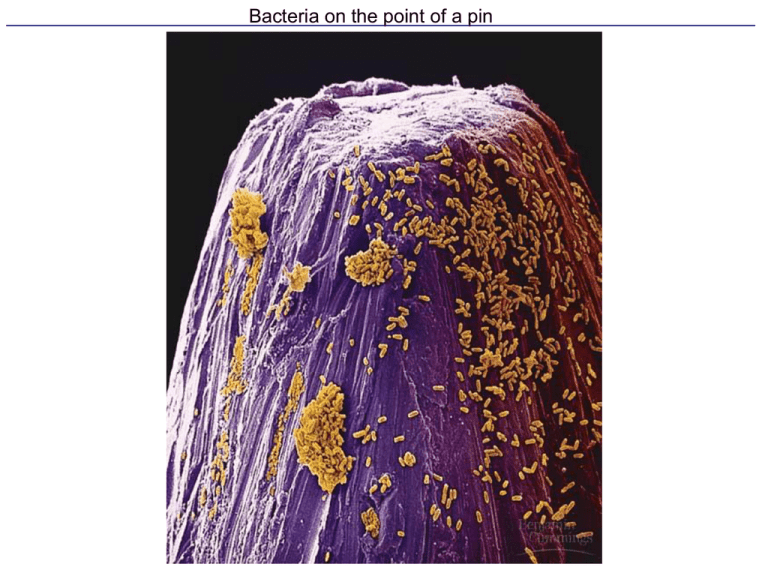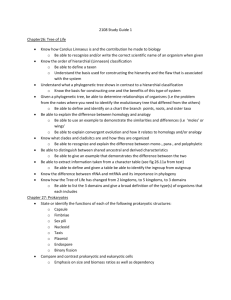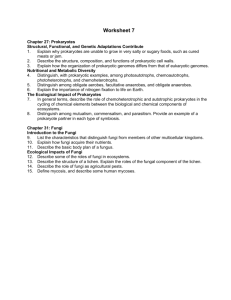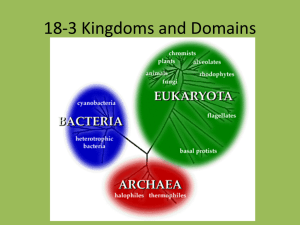Archaebacteria & Eubacteria
advertisement

Bacteria on the point of a pin The largest known prokaryote – a marine bacterium Thiomargarita namibiensis Archaebacteria & Eubacteria • prokaryotic cells • abundant • important decomposers and symbionts Prokaryotic Evolution • Kingdom Monera is NOT monophyletic • Two main branches – Archaebacteria = extreme environments – Eubacteria or Bacteria Molecular Classification 5 “Heat-loving” prokaryotes Extreme halophiles Prokaryotic Shapes Most prokaryotes have one of 3 basic shapes -Bacillus = Rod-shaped -Coccus = Spherical -Spirillum = Helical-shaped 9 Characteristics of Prokaryotes • Cell surfaces – Plasma membrane – cell walls of peptidoglycan in Eubacteria • Polysaccharides cross-linked with peptides • Archaea do not possess peptidoglycan – Some have pseudomurein – may have capsule or pili 11 Pili Prokaryotic flagella (Bacillus) Characteristics of Prokaryotes • Genome – in the nucleoid region – major chromosome • one doubled stranded DNA molecule forms a ring – Plasmids • Exchanged in conjugation Conjugation E. coli 15 Eukaryotic Origins The nucleus and endoplasmic reticulum arose from infoldings of prokaryotic cell membrane 16 Endosymbiotic theory • Eukaryotic organelles evolved from a consortium of symbiotic prokaryotes – mitochondria were aerobic heterotrophic prokaryotes – chloroplasts were photosynthetic prokaryotes 18 Kingdom Protista • Eukaryotic • Most are unicellular (there are some simple multicellular ones) Protista Taxonomy • Originally consisted of all unicellular eukaryotes • was paraphyletic • The 15 major protist phyla are grouped into seven major monophyletic groups -However, 60 lineages cannot be placed with confidence Protists 22 Protists 23 Characteristics Used to Classify Protists • • • • • Mode of locomotion mode of nutrition overall body form pigments & others… A ciliated protozoan Too diverse for one kingdom: Amoeba proteus, a unicellular "protozoan" Too diverse for one kingdom: a diatom, a unicellular "alga" Too diverse for one kingdom: a slime mold (Physarum polychalum) Too diverse for one kingdom: Australian bull kelp (Durvillea potatorum) Kingdom Fungi • Eukaryotes, mostly multicellular, heterotrophic, have cell walls (chitin) • decomposers, food, some cause disease • Acquire nutrients through absorption Defining Fungi Mycologists believe there may be as many as 1.5 million fungal species Fungi are classified into six main groups -Chytrids (aquatic, flagellated, ancestral) -Zygomycetes (bread molds) -Glomeromycetes (mycorrhizae) -Ascomycetes (bread yeast, truffles) -Basidiomycetes (mushrooms) -Deuteromycetes (Imperfect Fungi) 31 Defining Fungi 32 Phylogenetic Relationships There are five major fungal phyla -Based on mode of sexual reproduction 33 General Biology of the Fungi Multicellular fungi consist of long, slender filaments called hyphae -Some hyphae are continuous -Others are divided by septa 34 General Biology of the Fungi A mass of connected hyphae is called a mycelium -It grows through and digests its substrate 35 Fungal mycelia Fungal Parasites and Pathogens Largest Organism? Armillaria –a pathogenic fungus – 8 hectares 39 Fungi Reproduction • spores are produced either sexually or asexually • hyphae and spore nuclei are haploid – except for a brief diploid stage that occurs during sexual reproduction Figure 31.3 Generalized life cycle of fungi (Layer 1) Figure 31.3 Generalized life cycle of fungi (Layer 2) Figure 31.3 Generalized life cycle of fungi (Layer 3) Figure 31.6 The common mold Rhizopus decomposing strawberries Zygomycetes 45 Lichens • Mutualism between fungi and algae or cyanobacteria • Sensitive to pollution due to absorption capabilitues Mycorrhizae • Mutualism between fungi and the roots of 90% of all vascular plants • Increases absorption of phosphorous, zinc & other nutrients Ecology of Fungi 48





